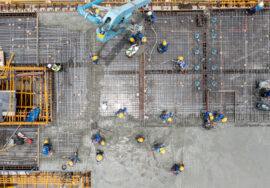How Building Technologies Are Enhancing Construction Efficiency
How Building Technologies Are Enhancing Construction Efficiency

Introduction
The construction industry is experiencing a significant transformation due to the rapid adoption of advanced building technologies. These innovations are reshaping the way projects are planned, executed, and maintained, leading to increased efficiency, reduced costs, and improved sustainability. This article explores how modern building technologies are enhancing construction efficiency and revolutionizing the industry.
Automation and Robotics in Construction
Automation and robotics are among the most impactful technologies in construction today. Robots are being used for tasks such as bricklaying, concrete pouring, and even welding. These machines can work around the clock with precision and consistency, significantly reducing human error and speeding up project timelines.
Additionally, drones are increasingly used to survey construction sites, capture real-time progress data, and ensure safety compliance. The use of such technology accelerates decision-making and allows project managers to identify potential issues early, ensuring smoother operations.
Building Information Modeling (BIM)
Building Information Modeling (BIM) is a digital representation of a building’s physical and functional characteristics. It provides a collaborative platform where architects, engineers, and contractors can work together in real-time. By improving communication and reducing design conflicts, BIM enhances project coordination and minimizes delays.
BIM also allows for more accurate project planning and cost estimation, reducing the likelihood of costly changes during construction. It streamlines the entire construction process, from design through to project completion, increasing efficiency and reducing waste.

Prefabrication and Modular Construction
Prefabrication and modular construction are growing trends in the industry, and for good reason. These techniques involve assembling parts of a building off-site in a controlled environment and then transporting them to the construction site for final assembly. This process reduces construction time, improves quality control, and minimizes disruptions at the construction site.
Prefabrication allows for simultaneous work on the building’s foundation and its components, cutting down overall project timelines. Additionally, because the components are produced in a factory setting, there is greater consistency and precision, which leads to fewer on-site errors and material waste.
Smart Construction Materials
New smart materials are being developed to improve the durability and efficiency of buildings. For example, self-healing concrete can repair its own cracks, reducing maintenance costs and increasing the lifespan of structures. Another innovation is translucent concrete, which allows natural light to pass through, reducing the need for artificial lighting in certain applications.
These materials not only enhance the performance of buildings but also contribute to faster construction processes by eliminating some of the manual labor typically required for maintenance and repairs. Their use leads to more sustainable and cost-effective construction projects.
3D Printing in Construction
3D printing is revolutionizing the construction industry by enabling the creation of complex structures with greater precision and speed. Entire houses and building components can be printed layer by layer, reducing the need for traditional construction materials and methods. 3D printing allows for the production of customized designs with minimal waste, significantly lowering material costs.
Furthermore, 3D-printed buildings can be completed in a fraction of the time it would take using conventional methods. This technology is particularly beneficial in constructing affordable housing or temporary structures for disaster relief efforts.
Energy-Efficient Technologies
Energy-efficient technologies are playing a crucial role in improving construction efficiency. Smart HVAC systems, LED lighting, and renewable energy sources like solar panels are being integrated into modern building designs. These technologies not only reduce a building’s operational costs but also contribute to more efficient construction processes by enabling real-time monitoring and optimization of energy use during the build.
Green building certifications, such as LEED, are also driving the adoption of energy-efficient technologies, as construction companies aim to meet higher sustainability standards while improving efficiency.
Conclusion
Building technologies are revolutionizing construction efficiency by introducing automation, improving project collaboration, and enabling innovative materials and methods. From BIM to robotics and energy-efficient systems, these advancements are streamlining construction processes, reducing costs, and contributing to more sustainable practices. As the industry continues to adopt these innovations, we can expect even greater improvements in the speed, quality, and sustainability of construction projects.
For more information on how technology is enhancing construction efficiency, visit Construction Dive or explore the latest advancements in smart building technology.
For inquiries about incorporating these technologies into your construction project, contact us here.
Read more related articles to enhance your knowledge and make informed decisions
10 Essential Steps in the Building Construction Process
How to Choose the Right Materials for Your Construction Project








